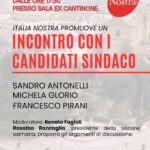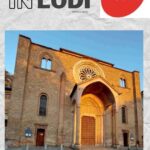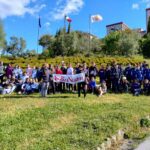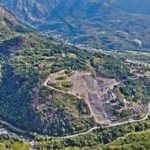Brussels/ Amsterdam, 11 June 2011 – The 27 winners of the 2011
European Union Prize for Cultural Heritage / Europa Nostra Awards were honoured yesterday evening during a ceremony at Amsterdam’s historic concert hall, the ‘Concertgebouw’. The awards were presented by Androulla Vassiliou, European Commissioner for Education, Culture, Multilingualism and Youth, and Plácido Domingo, the world-renowned tenor and president of Europa Nostra. Six of the 27 winners were named last night as ‘Grand Prix’ laureates in recognition of their outstanding heritage achievements. The ceremony was attended by an audience of some 1500 people including H.R.H. Princess Margriet of The Netherlands.
“All the winners represent extraordinary accomplishments in cultural heritage and will serve as inspiration to professionals and volunteers, without whom in many cases our heritage would be at risk. Cultural heritage is an essential part of Europe‘s cultural diversity and shared history; it brings together our past, present and future. It helps to regenerate neighbourhoods and brings people from different backgrounds together. It has also helped to make Europe the world’s top tourist destination and contributes significantly to the Union‘s economy,” said Commissioner Vassiliou.
“These exemplary achievements are sending a strong message to everyone in Europe. The value of cultural heritage is essential for Europe – for the economy and for our social cohesion – but above all for our sense of belonging and our sense of pride and happiness,“ added Europa Nostra’s President, Plácido Domingo.
The six Grand Prix winners are:
- Station Antwerpen Centraal (Antwerp Central Station), Antwerp, Belgium
- Preindustrial buildings in Ademuz / Sesga, Ademuz, Valencia, Spain
- The Hackfall woodland garden, Grewelthorpe, North Yorkshire, United Kingdom
- Architectural heritage of the buffer zone in the walled city of Nicosia, Cyprus
- Szymon Modrzejewski, Uście Gorlickie, Poland
- Weald & Downland open air museum, Chichester, West Sussex, United Kingdom
Jury’s comments on the six Grand Prix projects:
Category 1 — Conservation
This project’s award recognises the exceptional achievement of transforming a terminal station – typical for 19th century railway architecture – into a through station – a necessity in the 21st century – while restoring the monumental railway station building to its former glory. The positive interaction of the refurbished station with its surrounding urban landscape proves that the preservation of the existing station was the only option.
The conserved vernacular structures including their contents are outstanding because they beautifully recall the former local way of life and reflect the collective memories and activities of this rural area in their true context and landscape. Their careful restoration and enhancement deserves to be an inspiration for similar rural areas throughout Europe.
Hackfall has enjoyed a renaissance due to its restoration undertaken by a combination of professional experts and enthusiastic volunteers, which have faithfully followed the imaginative vision of its 17th century founder. The Jury was captivated by the authenticity of the restoration of the ruined buildings, highlighting the garden’s poetic communion with nature.
Category 2 – Research
This project was unanimously acclaimed by the jury as a fine and comprehensive study of all the buildings within the UN protected buffer zone of Nicosia, originally the heart of this walled city. Many problems had to be overcome in carrying out the work, which involved scientists and other workers from both the Greek Cypriot and Turkish Cypriot communities. The project is particularly important because of its potential to help alleviate the difficulties between the two sides, and is an excellent example of a conservation project in a sensitive area of Europe.
Category 3 — Dedicated service
For more than 23 years, Simon Modrzejewski has recognised that the tombs and cemeteries of those who once lived in the regions of Bieszcady and Beskid Niski in Southeast Poland make up a significant part of their regional cultural heritage, and that their restoration enables those who live there today to create a human connection with the heritage of others and of the past. He has selflessly given his own time and skill, and in doing so, has engaged local people and young people in caring for this heritage, which is not only ‘theirs’ but is important to all of us.
Category 4 — Education, training and awareness-raising
The Jury has granted this award for the exemplary initiative and long standing commitment of the Weald & Downland Open Air Museum for creating a centre for training in historic building conservation. The centre is creating the next generation of skilled personnel for historic building conservation, while involving the wider public and a large number of volunteers through an inspirational learning environment.
Background
H.R.H. Princess Margriet hosted a reception for the winners at the Royal Palace before the ceremony started. Other VIP guests at the ceremony in the Concertgebouw included Géza Szőcs, Hungarian State Secretary for Culture. Musicians from the European Opera Centre and the European Union Youth Orchestra closed the event with a rare performance of Franz Liszt’s only opera, Don Sanche.
The winners (including the 6 Grand Prix laureates) were selected from nearly 140 submitted projects in 31 countries. The final choice was made by juries composed of independent experts from across Europe. Each of the winners received a plaque or a trophy; the six ‘Grand Prix’ winners also received €10,000 each.
Cultural heritage brings a significant – and often underrated – contribution to growth and job creation. The sector represents an important part of the cultural and creative industries, which provide jobs for 8.5 million people in the EU and contribute 4.5% to Europe’s GDP. Spending on conservation of cultural heritage by public and private bodies is worth an estimated €5 billion a year.
Figures published by the Organisation for Economic Co-operation and Development (OECD) show that 40% of worldwide international tourism has a cultural dimension. Cultural heritage is also a key resource for sustainable development and social cohesion.
The awards have been supported by the Culture Programme of the European Union since 2002. The Culture Programme has invested €26 million in co-financing heritage projects since 2007. Other EU-funded programmes also provide support in this area: the European Regional Development Fund allocates €3 billion for the protection and preservation of cultural heritage, €2.2 billion for the development of cultural infrastructure and €775 million to support cultural services for 2007-2013; a further €89 million has been made available through EU Framework Programmes for Research and Technological Development since 1998.






